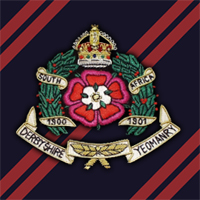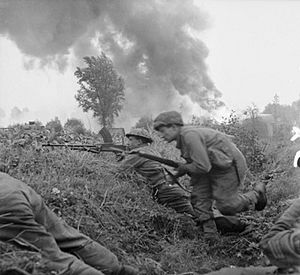Derbyshire Yeomanry facts for kids
Quick facts for kids Derbyshire Yeomanry |
|
|---|---|

Cap badge of The Derbyshire Yeomanry
|
|
| Active | 22 October 1794 – 2 February 1957 |
| Country | |
| Branch | |
| Type | Yeomanry |
| Size | Regiment |
| Engagements | South Africa 1900–01 World War I
|
The Derbyshire Yeomanry was a special group of soldiers in the British Army. It started in 1794. This group served as cavalry (soldiers on horseback) and later as infantry (soldiers on foot) in the First World War. In the Second World War, they became two reconnaissance regiments, which means they were good at scouting and finding out what the enemy was doing. In 1957, they joined with another group called the Leicestershire Yeomanry to form the Leicestershire and Derbyshire (Prince Albert's Own) Yeomanry.
History of the Derbyshire Yeomanry
How the Regiment Started
The Derbyshire Yeomanry first formed in 1794. It was called the Derbyshire Corps of Fencible Cavalry. These were full-time soldiers whose job was to defend Britain at home. Soon after, it changed to the Derbyshire Corps of Yeomanry Cavalry. This group was made of part-time soldiers who trained to be ready if needed.
In 1834, these smaller groups joined together to form the Derbyshire Yeomanry Cavalry. In 1900, some of their members went to fight in the South African War. By 1901, the group changed again to become mounted infantry, meaning they rode horses but fought on foot. In 1908, they became part of the Territorial Force, which was a volunteer army. They went back to being cavalry, riding horses like dragoons, and were called The Derbyshire Yeomanry. Their main base was in Derby.
The First World War (1914-1918)
When the First World War began in 1914, the Territorial Force was mainly for home defence. But many soldiers volunteered to fight overseas. So, units like the Derbyshire Yeomanry were split into different groups:
- 1st Line: These soldiers could go fight overseas.
- 2nd Line: These soldiers stayed home, often because they couldn't or didn't want to go overseas.
- 3rd Line: This group trained new soldiers to replace those fighting.
1st Derbyshire Yeomanry in WWI
The 1st Derbyshire Yeomanry got ready for war in August 1914. They stayed in England until 1915, then moved to Egypt. From there, they sailed to Gallipoli. They fought as dismounted infantry, meaning they left their horses and fought on foot. They suffered many losses there.
After returning to Egypt in December, they helped fight in the Senussi Campaign. In February 1916, they moved to Salonika in Greece. They stayed in Macedonia until the war ended, often as a reserve force.
2nd Derbyshire Yeomanry in WWI
The 2nd Line regiment formed in 1914. They were based at Chatsworth and later near King's Lynn. In 1916, many yeomanry units in the UK changed. Most became cyclists, so the 2nd Derbyshire Yeomanry also started using bicycles instead of horses.
They were based near Canterbury for much of the war. In October 1916, about 165 men and four officers from this group were sent to France to help another infantry unit.
Between the World Wars
After the First World War, in 1920, the regiment became part of the Territorial Army again. Many yeomanry regiments changed their roles. In 1921, the Derbyshire Yeomanry became the 24th (Derbyshire Yeomanry) Armoured Car Company. This meant they used armoured cars instead of horses.
In 1923, they joined the Royal Tank Corps. By 1939, it was clear another war was coming. The Territorial Army was doubled in size. The Derbyshire Yeomanry became a full regiment again, called the 1st Derbyshire Yeomanry. They also formed a new, separate group called the 2nd Derbyshire Yeomanry.
The Second World War (1939-1945)
1st Derbyshire Yeomanry in WWII
The 1st Derbyshire Yeomanry arrived in Tunisia in late 1942. They were the reconnaissance regiment for the 6th Armoured Division. They fought in battles like Medjez el Bab and Kasserine Pass. They reached Tunis in March 1943.
Then, the 1st Derbyshire Yeomanry moved to Italy with the 6th Armoured Division. They fought hard in May 1944, including at the Battle of Monte Cassino. They also fought in the advance towards Florence and in other battles in 1945.
2nd Derbyshire Yeomanry in WWII
In 1942, the 2nd Derbyshire Yeomanry fought in North Africa. They were part of the 7th Armoured Division and took part in important battles like Battle of Alam el Halfa and the Second Battle of El Alamein.
They returned to the UK in late 1943. Then, they became the reconnaissance regiment for the 51st (Highland) Infantry Division until the war ended. They fought in many important actions in Europe. These included battles in France, on the Lower Maas, and during the Battle of the Bulge in January 1945. They also fought in the Rhineland and crossed the Rhine River in March 1945 as part of Operation Plunder.
After the Wars
The Derbyshire Yeomanry was restarted in the Territorial Army in 1947. Their main base remained in Derby. On February 9, 1957, they joined with The Leicestershire Yeomanry (Prince Albert's Own). Together, they formed The Leicestershire and Derbyshire (Prince Albert's Own) Yeomanry.
Regimental Museum
You can learn more about the Derbyshire Yeomanry at the Derby Museum and Art Gallery. They have a special "Soldier's Story Gallery" that shows items from the regiment's history.
Battle Honours
Battle honours are special awards given to military units for their bravery and success in battles. The Derbyshire Yeomanry earned many battle honours, including:
- Second Boer War: South Africa 1900–01
- World War I: Struma, Macedonia 1916–18, Suvla, Scimitar Hill, Gallipoli 1915, Egypt 1915–16
- World War II: Dives Crossing, La Vie Crossing, Lisieux, Lower Maas, Ourthe, Rhineland, Reichswald, North-West Europe 1944–45, Alam El Halfa, El Alamein, Medjez el Bab, Tabourba Gap, Bou Arada, Kasserine, Steamroller Farm, Maknassy, Fondouk, Kairouan, El Kourzai, Tunis, North Africa 1942–43, Cassino II, Liri Valley, Aquino, Arezzo, Advance to Florence, Argenta Gap, Fossa Cembalina, Italy 1944–45
See also
- Imperial Yeomanry
- List of Yeomanry Regiments 1908
- Yeomanry
- Yeomanry order of precedence
- British yeomanry during the First World War
- Second line yeomanry regiments of the British Army


